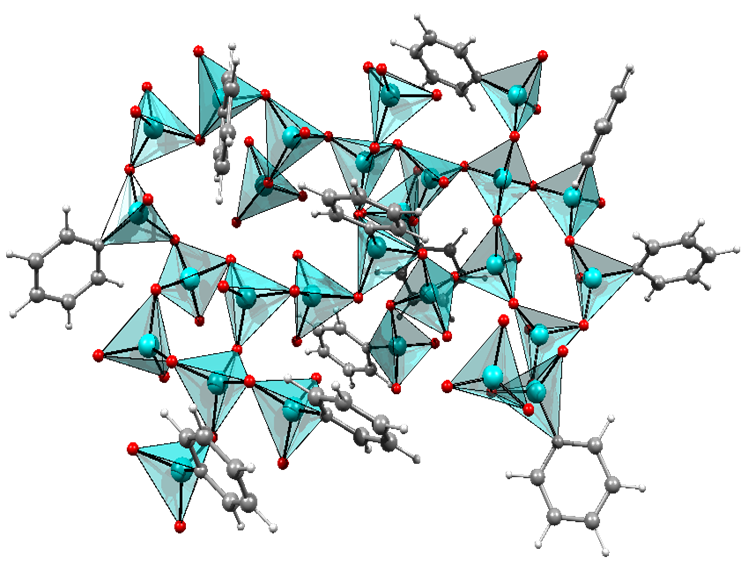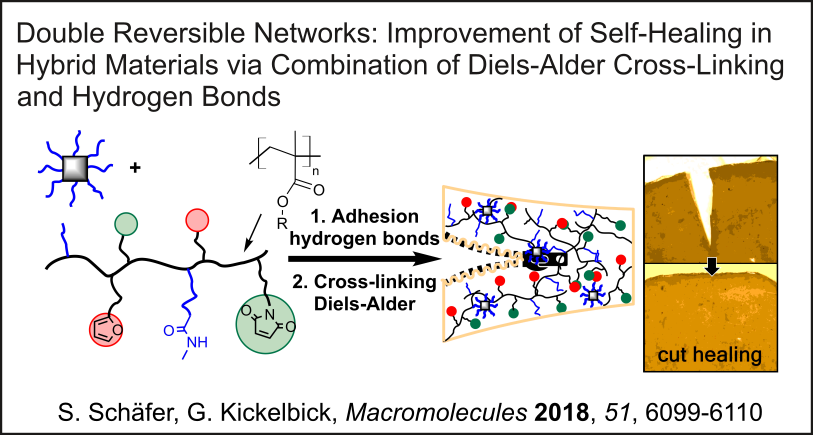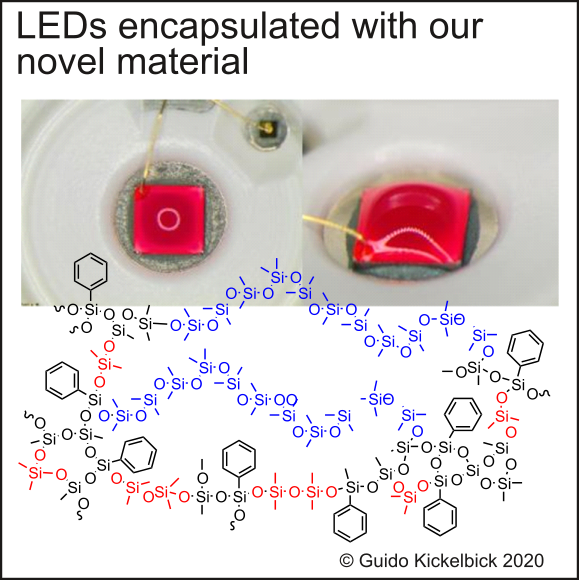Hybrid- and nanomaterials

The combination of inorganic and organic components on a molecular or nanometer length scale enables the development of innovative materials with properties that either lie between those of the original substances or have completely new functionalities. Through the targeted chemical combination of different compounds, for example, optically transparent plastics with high scratch resistance and thermal stability or conductive organic polymers are created through the integration of inorganic components. A central goal of our work is to synthesize materials that are as homogeneous as possible, which requires precise control over numerous reaction parameters. To enable the controlled construction of such materials, we systematically analyze the structure-property relationships.
Our research approach is based on the functional attachment of organic groups to inorganic molecules, for example through coordinative or covalent interactions. These molecular model systems enable us to study the interactions between the inorganic and organic components in detail - for example using NMR or IR spectroscopy. The knowledge gained from this helps us to better understand the behavior of other interfaces, such as the surface of nanoparticles. By combining various production methods and characterization techniques from chemistry, physics and materials science, we record the structure-property relationships down to the macroscopic material properties.
The current research focus of our group in the area of hybrid materials is the development of self-healing materials and the synthesis of novel encapsulation systems for optoelectronic applications. Both projects focus on the modification of a polymer backbone, which is given customized properties through the targeted integration of molecular or nanoparticular structures.

In our research area on self-healing materials, we develop nanocomposites in which inorganic nanoparticles are integrated into a polymer matrix. Through targeted chemical functionalization of the interfaces between the components, we add switchable properties that enable the material to repair itself in the event of mechanical damage by applying external heat. We are also currently researching innovative methods of inductive heating in order to repair damage efficiently and in a targeted manner.

In the field of encapsulation systems for optoelectronic applications, we are working on materials with high optical transparency and high thermal and photochemical stability. We use silicones and their derivatives as a class of materials for this purpose. Using a newly developed process, we have succeeded in producing single-component materials that crosslink without the use of catalysts and can be processed using a simple thermal process. These materials offer an optimum combination of stability and transparency and represent a promising alternative to conventional products.
Related literature:
Books:
Hybrid Materials: Synthesis, Characterization, and Applications, G. Kickelbick (Hrsg.), Wiley-VCH, Weinheim, 2007.
Book chapters:
- Nanoparticles and Composites, G. Kickelbick in The Sol-Gel Handbook - Synthesis, Characterization, and Applications, (3-Volume Set), (Eds. D. Levy, M. Zayat) Wiley-VCH, 2015, Weinheim, Germany, pp. 227-239.
- Thermally remendable polymers, T. Engel, G. Kickelbick, in Self-Healing Polymers, Edited by W.H. Binder, Wiley-VCH, Weinheim, 2013, pp. 153-169.
Reviews:
- Hybrid Materials – Past, Present and Future, G. Kickelbick, Hybrid Materials 2014, 1. doi:10.2478/hyma-2014-0001
- The search of a homogeneously dispersed material-the art of handling the organic polymer/metal oxide interface, G. Kickelbick, J. Sol-Gel Sci. Technol. 2008, 46, 281-290. doi: 10.1007/s10971-008-1731-2
- Homogen und doch so heterogen, Nanokomposite: anorganisch + organisch, G. Kickelbick, Chemie in unserer Zeit 2005, 39, 46-53. doi:10.1002/ciuz.200400339
- Concepts for Incorporation of Inorganic Building Blocks into Organic Polymers on a Nanoscale, G. Kickelbick, Progr. Polym. Sci.200328, 83-114. doi: 10.1016/S0079-6700(02)00019-9
Scientific papers:
- Self-Healing Iron Oxide Polyelectrolyte Nanocomposites: Influence of Particle Agglomeration and Water on Mechanical Properties, B. Oberhausen, A. Plohl, B.-J. Niebuur, S. Diebels, A. Jung, T. Kraus, G. Kickelbick, Nanomaterials 2023, 13, 2983, doi: 10.3390/nano13232983.
- Self-Activation of Inorganic-Organic Hybrids Derived through Continuous Synthesis of Polyoxomolybdate and para-Phenylenediamine Enables Very High Lithium-Ion Storage Capacity, M. A. Mohamed, S. Arnold, O. Janka, A. Quade, V. Presser, G. Kickelbick, ChemSusChem 2023, 16, e202202213, doi: 10.1002/cssc.202202213.
- Performant flexible luminescent solar concentrators of phenylpolysiloxanes crosslinked with perylene bisimide fluorophores, E. Della Latta, F. Sabatini, C. Micheletti, M. Carlotti, F. Martini, F. Nardelli, A. Battisti, I. Degano, M. Geppi, A. Pucci, S. Pohl, G. Kickelbick, Polym. Chem. 2023, 14, 1602-1612, doi: 10.1039/d2py01428a.
- High-Refractive-Index Polysiloxanes Containing Naphthyl and Phenanthrenyl Groups and Their Thermally Cross-Linked Resins, M. Briesenick, M. Gallei, G. Kickelbick, Macromolecules 2022, 55, 4675-4691, doi: 10.1021/acs.macromol.2c00265.
- Thermoplastic Silsesquioxane Hybrid Polymers with a Local Ladder-Type Structure, S. Pohl, O. Janka, E. Füglein, G. Kickelbick, Macromolecules 2021, 54, 3873-3885, doi: 10.1021/acs.macromol.1c00310.
- Perylene polyphenylmethylsiloxanes for optoelectronic applications, N. Steinbrueck, G. Kickelbick, J. Polym. Sci., Part B: Polym. Phys. 2019, 57, 1062-1073. doi:10.1002/polb.24861
- Platinum free thermally curable siloxanes for optoelectronic application - synthesis and properties, N. Steinbrueck, S. Pohl, G. Kickelbick, RSC Adv. 2019, 9, 2205-2216. doi:10.1039/c8ra09801h
- Double Reversible Networks: Improvement of Self-Healing in Hybrid Materials via Combination of Diels-Alder Cross-Linking and Hydrogen Bonds, S. Schaefer, G. Kickelbick, Macromolecules 2018, 51, 6099-6110. doi:10.1021/acs.macromol.8b00601
